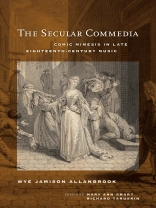Wye Jamison Allanbrook’s
The Secular Commedia is a stimulating and original rethinking of the music of the late eighteenth century. Hearing the symphonies and concertos of Haydn and Mozart with an ear tuned to operatic style, as their earliest listeners did, Allanbrook shows that this familiar music is built on a set of mimetic associations drawn from conventional modes of depicting character and emotion in opera buffa. Allanbrook mines a rich trove of writings by eighteenth-century philosophers and music theorists to show that vocal music was considered aesthetically superior to instrumental music and that listeners easily perceived the theatrical tropes that underpinned the style. Tracing Enlightenment notions of character and expression back to Greek and Latin writings about comedy and drama, she strips away preoccupations with symphonic form and teleology to reveal anew the kaleidoscopic variety and gestural vitality of the musical surface. In prose as graceful and nimble as the music she discusses, Allanbrook elucidates the idiom of this period for contemporary readers. With notes, musical examples, and a foreword by editors Mary Ann Smart and Richard Taruskin.
Tabela de Conteúdo
List of Illustrations
Foreword
Mary Ann Smart and Richard Taruskin
1. Comic Flux and Comic Precision
2. Comic Voice in the Late Mimetic Period
3. The Comic Surface
4. Comic Finitude and Comic Closure
Notes
Bibliography
Index
Sobre o autor
Wye Jamison Allanbrook was Professor of Music at the University of California, Berkeley, and author of Rhythmic Gesture in Mozart.Mary Ann Smart is Professor of Music at the University of California, Berkeley, and author of Mimomania: Music and Gesture in Nineteenth-Century Opera.Richard Taruskin is Professor of Music at the University of California, Berkeley, and author of many books on Russian and Western music, including the six-volume Oxford History of Western Music.












